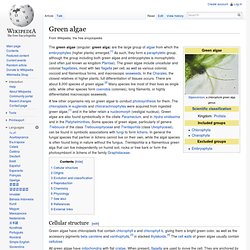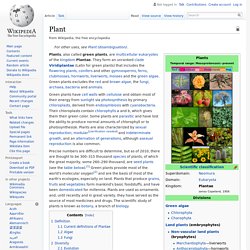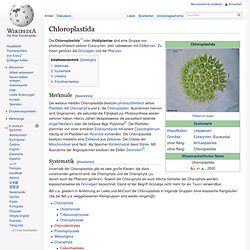

Charophyta. Mesostigmatophyceae (syn. Chaetosphaeridiophyta) Prasinophytae. Chlorodendrales. Chlorophyta. Streptophyta. Green algae. The green algae (singular: green alga) are the large group of algae from which the embryophytes (higher plants) emerged.[1] As such, they form a paraphyletic group, although the group including both green algae and embryophytes is monophyletic (and often just known as kingdom Plantae).

The green algae include unicellular and colonial flagellates, most with two flagella per cell, as well as various colonial, coccoid and filamentous forms, and macroscopic seaweeds. In the Charales, the closest relatives of higher plants, full differentiation of tissues occurs. There are about 8,000 species of green algae.[2] Many species live most of their lives as single cells, while other species form coenobia (colonies), long filaments, or highly differentiated macroscopic seaweeds. Cellular structure[edit] All green algae have mitochondria with flat cristae. Origins[edit] Evolution and classification[edit] A growth of the green seaweed, Enteromorpha on rock substratum at the ocean shore. Viridiplantae. Plant. Green plants have cell walls with cellulose and obtain most of their energy from sunlight via photosynthesis by primary chloroplasts, derived from endosymbiosis with cyanobacteria.

Their chloroplasts contain chlorophylls a and b, which gives them their green color. Some plants are parasitic and have lost the ability to produce normal amounts of chlorophyll or to photosynthesize. Plants are also characterized by sexual reproduction, modular[clarification needed] and indeterminate growth, and an alternation of generations, although asexual reproduction is also common. Precise numbers are difficult to determine, but as of 2010[update], there are thought to be 300–315 thousand species of plants, of which the great majority, some 260–290 thousand, are seed plants (see the table below).[1] Green plants provide most of the world's molecular oxygen[2] and are the basis of most of the earth's ecologies, especially on land.
Definition Current definitions of Plantae Algae Fungi Diversity Evolution. Chloroplastida. Die Chloroplastida[1] oder Viridiplantae sind eine Gruppe von photosynthetisch aktiven Eukaryoten, also Lebewesen mit Zellkernen.

Zu ihnen gehören die Grünalgen und die Pflanzen. Merkmale[Bearbeiten] Die weitaus meisten Chloroplastida besitzen photosynthetisch aktive Plastiden mit Chlorophyll a und b, die Chloroplasten. Ausnahmen hiervon sind Organismen, die sekundär die Fähigkeit zur Photosynthese wieder verloren haben. Hierzu zählen beispielsweise die parasitisch lebende Vogel-Nestwurz oder die farblose Alge Polytoma[2]. Systematik[Bearbeiten] Innerhalb der Chloroplastida gibt es zwei große Kladen, die stark voneinander getrennt sind: die Chlorophyta und die Charophyta (zu denen auch die Pflanzen gehören). Adl u.a. gliedern in Anlehnung an Lewis und McCourt die Chloroplastida in folgende Gruppen ohne klassische Rangstufen (die bei Adl u.a. weggelassenen Kleingruppen sind wieder eingefügt): Literatur[Bearbeiten] Louise A.
Viridiplantae. Viridiplantae (literally "green plants")[1] are a clade comprising the embryophytes (land plants), and the related green algae which are primarily aquatic. [2] [3][4] Together with Rhodophyta and glaucophytes, Viridaeplantae are thought to belong to a larger clade called Archaeplastida or Primoplantae.

The monophyletic Chlorophyta and Streptophyta are classified under Viridiplantae.[7] More than 350,000 species of Viridiplantae exist.[8] A taxonomic evaluation of eukaryotes based on myosin distribution showed the Viridiplantae lost class-I myosins.[9] Phylogeny and classification[edit] Leliaert et al. 2012[edit] Simplified phylogeny of the Viridiplantae, according to Leliaert et al. 2012.[10] Viridiplantae Chlorophyta core chlorophytes Ulvophyceae Chlorophyceae Trebouxiophyceae prasinophytes (paraphyletic)